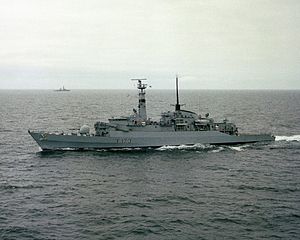Type 21 frigate

|
|
| Class overview | |
|---|---|
| Name: | Type 21 Amazon |
| Builders: | |
| Operators: | |
| Preceded by: | Type 12M Leander |
| Succeeded by: | Type 22 Broadsword |
| Subclasses: | |
| In commission: | 11 May 1974 |
| Completed: | 8 |
| Active: | 5 |
| Lost: | 2 |
| Retired: | 1 |
| General characteristics | |
| Type: | Frigate |
| Displacement: |
|
| Length: | |
| Beam: | 41.8 ft (12.7 m) |
| Draught: | 19 ft (5.8 m) |
| Propulsion: | |
| Speed: |
|
| Range: |
|
| Complement: | 13 officers, 164 ratings |
| Sensors and processing systems: |
|
| Armament: |
|
| Aircraft carried: | 1 × Wasp or Lynx |
| Aviation facilities: | Flight deck and hangar |
The Type 21 frigate, or Amazon-class frigate, was a British Royal Navy general-purpose escort that was designed in the late 1960s, built in the 1970s and served throughout the 1980s into the 1990s.
In the mid-1960s, the Royal Navy had a requirement for a replacement for the diesel-powered Leopard-class and Salisbury-class frigates. While the Royal Navy's warships were traditionally designed by the Ministry of Defence's Ship Department based at Bath, private shipyards (in particular Vosper Thorneycroft) campaigned for the right to design and build a ship to meet this requirement. Vospers claimed that, by ignoring what they claimed to be the conservative design practices followed by the MoD team at Bath, they could deliver the new frigate at a significantly lower price (£3.5 million compared with the £5 million price of the contemporary Leander class), while being attractive to export customers.
The class was ordered under political and Treasury pressure for a relatively cheap, yet modern, general purpose escort vessel which would be attractive to governments and officers of South America and Australasia -the traditional export markets of British shipyards. It was also envisaged as an out-of-area RN gunboat that would retain UK presence in those areas, as well as the Caribbean and the Gulf; essentially replacing the diesel Types Type 41, Type 61 and COSAG Type 81 with smaller crewed vessels. The RN staff disliked the idea and would have preferred, like many USN Admirals, to continue to develop steam types - in the RN's case, the Leander class, which was regarded as an especially successful and quiet anti-submarine hunter, but was seen by the politicians as dated and by the Treasury and export-oriented shipyards as too expensive to market. The development of Vosper's own export designs, the Mk 5 for Iran and the Mk 7 for Libya, increased the pressure on the Admiralty to accept this line of naval development, which seemed to offer a cheap export frigate with a range of 6,000 nm, a top speed of 37 knots, a superficially good armament of the new Mark 8 4.5 inch gun, facilities for a Westland Wasp helicopter, anti-ship missiles and two triple lightweight Seacat missile launchers. When plans for the new Libyan frigate, Dat Assawari, were finalised in 1968, the Admiralty board accepted its paper specifications were unanswerable and they would have to allow the shipyards to develop a low cost fill in a/s and general purpose version for the RN that would be stretched and fully gas turbine powered rather than CODAG like the Mk 5 and Mk 7. In reality, it was a much more difficult design, with the RN requiring the extra internal weight of the Computer Assisted Action Information System (CAAIS) computer command systems and the lack of heavy diesels or a steam plant low in the hull to balance the heavy top weight of CAAIS. The fitting of Tyne gas turbines for cruising, instead of the diesels used in the Iranian and Libyan versions, meant fuel consumption and cost would be high, which was a tremendous problem for the Royal Navy in the early 1980s when the austerity of early Thatcherism, cut the Royal Navy fuel allowance and meant most frigates spent more time tied up, rather than at sea in 1980-1, and despite the smaller crew, running costs of the Type 21 were ten percent higher than the Leanders. The Type 21 would provide the shipyards with experience in building fully gas turbine powered ships and provide them with useful work for the shipyards while the Type 42 destroyer and Type 22 frigate would not be ready until the mid-to-late 1970s. As the Admiralty design board were busy with the latter, the Type 21 project was given to private shipyards Vosper Thornycroft and Yarrow. The unmistakably yacht-like and rakish lines were indicative of their commercial design. Their handsome looks combined with their impressive handling and acceleration lent itself to the class nickname of Porsches.
...
Wikipedia
